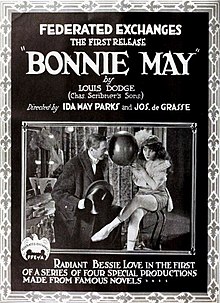Bonnie May
| Bonnie May | |
|---|---|
 Magazine advertisement | |
| Directed by | |
| Based on | Bonnie May (novel) by Louis Dodge |
| Produced by | Andrew J. Callaghan |
| Starring |
|
| Cinematography | Sam Landers[1] |
Production companies | Andrew J. Callaghan Productions, Inc.[2] |
| Distributed by | Federated Film Exchanges of America, Inc.[3] |
Release date |
|
Running time | 5 reels[4] |
| Country | United States |
| Language | Silent (English intertitles) |
| Budget | $75,000[5] |
Bonnie May is a lost[6] silent 1920 American comedy-drama[7] film based on the 1916 novel by Louis Dodge.[8][9] It was directed by Ida May Park and Joseph De Grasse[10] and starred Bessie Love. It was produced by Andrew J. Callaghan Productions[2] and distributed by Federated Film Exchanges of America, Inc.[3]
Plot[edit]
An orphaned girl (Love) grows up in the theater. She becomes smarter and stronger, and never loses her optimism.[11]
Cast[edit]
- Bessie Love[12]
- Charles Gordon
- William Herbert Bainbridge
- Lon Poff
- Miss DuPont[1]
Release[edit]
As this was Bessie Love's first film with Film Exchanges of America, Inc., it was very heavily promoted. A thirty-eight page press book was created, as well as special souvenir mirrors.[13]
On its release, it was shown with The Son of Tarzan; Mystic Mush, a Hank Mann comedy; and a Mutt and Jeff cartoon.[7]
After its release, producer Andrew J. Callaghan sued Federated Film Exchanges, saying that the distributor had not paid the full amount to distribute this film, The Midlanders, and Penny of Top Hill Trail.[5]
Reception[edit]
The film received positive reviews.[14] Author Louis Dodge, who wrote the novel on which the film is based, highly praised Love's performance.[15]
References[edit]
- ^ a b Love, Bessie (1977). From Hollywood with Love: An Autobiography of Bessie Love. London: Elm Tree Books. p. 150. OCLC 734075937.
- ^ a b "Celebrated Exchange to Handle Feature Films". Moving Picture World. November 13, 1920. p. 200.
- ^ a b c "Federated Exchanges Announce The Release of the First Super-Production Starring Bessie Love. 'Bonnie May'". Exhibitors Herald. October 16, 1920. pp. 30–31.
- ^ "Federated Exchanges". Exhibitors Herald. November 27, 1920. p. 102.
- ^ a b "Callaghan Asks Injunction Restraining Federated from Exhibiting Productions". Moving Picture World. August 6, 1921. p. 592.
- ^ The Library of Congress/FIAF American Silent Feature Film Survival Catalog:Bonnie May
- ^ a b "Stanford Theatre Palo Alto". The Daily Palo Alto. Vol. 59, no. 66. June 3, 1921. p. 4.
- ^ Goble, Alan, ed. (September 8, 2011). The Complete Index to Literary Sources in Film. p. 129. ISBN 978-3-11-095194-3.
- ^ Dodge, Louis (1916). Bonnie May. New York: Charles Scribner's Sons. OCLC 7631985.
- ^ "Two Directors Get Big Results in "Bonnie May"". Exhibitors Herald. September 11, 1920. p. 53.
- ^ "Bessie Love Here in 'Bonnie May'". The Southeast Missourian. December 29, 1920. p. 5.
- ^ Motion Picture Studio Directory and Trade Annual 1921. Motion Picture News, Inc. 1921. pp. 155, 174, 196, 230, 261.
- ^ "'Bonnie May' Given Strong Exploitation". Exhibitors Herald. October 9, 1920. p. 89.
- ^ Riley, R. Ross. "Bonnie May (Federated), with Bessie Love". Exhibitors Herald.
Boy, she was a dinger. A good clean story, and real acting.
- ^ "Consider Federated Ideal Medium of Distribution for Any Picture Author Declares that Bessie Love's Portrayal in First Production 'Will Certainly Be a Triumph For Bonnie May'". Exhibitors Herald. September 11, 1920. p. 56.
It seems to be an entirely happy inspiration which brought Miss Bessie Love and Bonnie May together. While I had never seen the beautiful and intelligent work of Miss Love at the time I wrote my book, it might almost seem that she had supplied the model for my study. I predict that when Miss Love portrays the character, she will—to paraphrase an old anecdote—not merely enact, but actually be, Bonnie May. It will very certainly be a triumph for Bonnie May. I hope also it will be a triumph for Bessie Love.
External links[edit]
- 1920 films
- 1920 comedy-drama films
- 1920 lost films
- American black-and-white films
- American silent feature films
- Films based on American novels
- Films directed by Ida May Park
- Lost American comedy-drama films
- 1920s American films
- Silent American comedy-drama films
- 1920s English-language films
- English-language comedy-drama films
